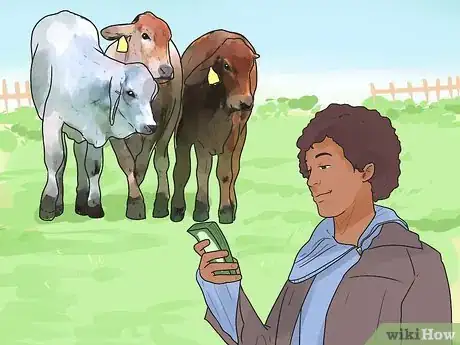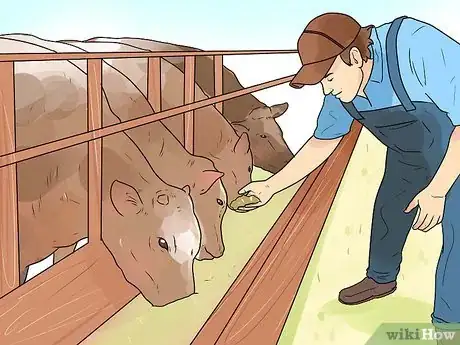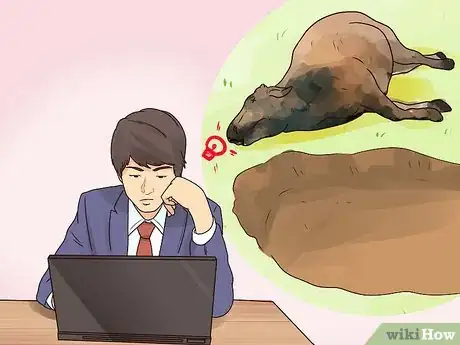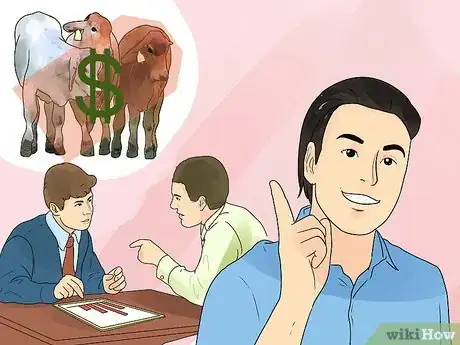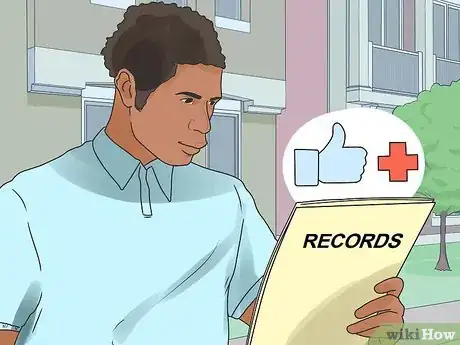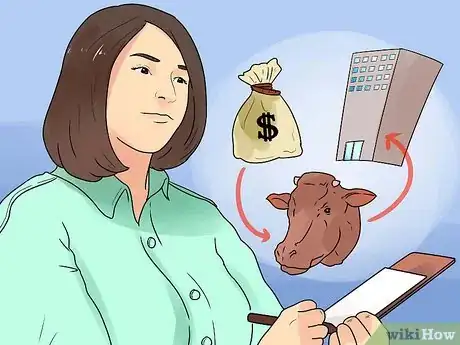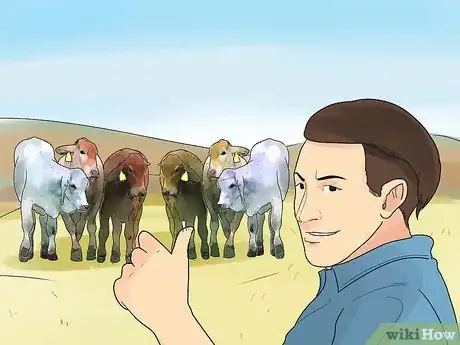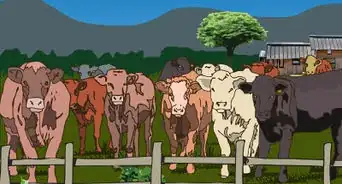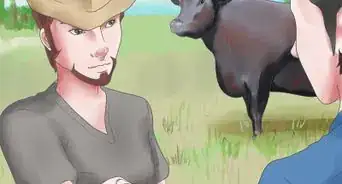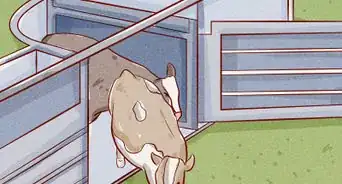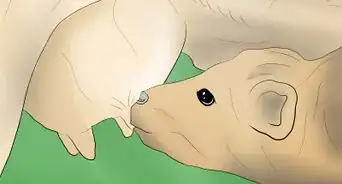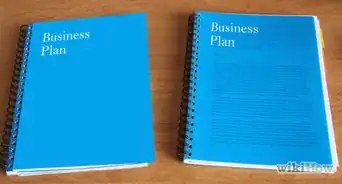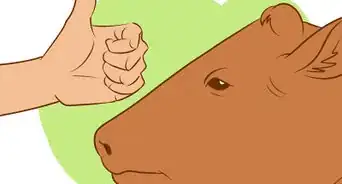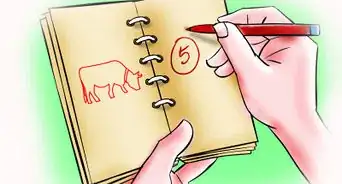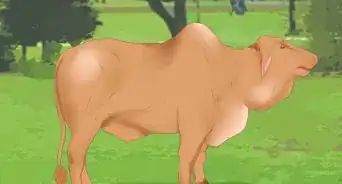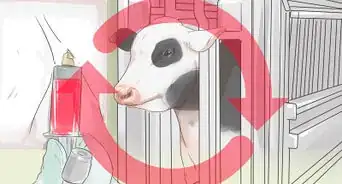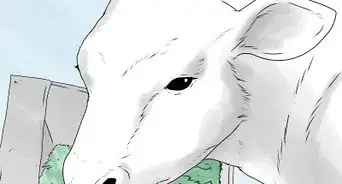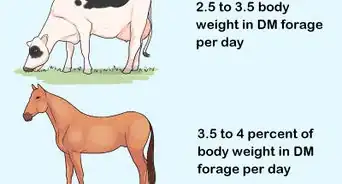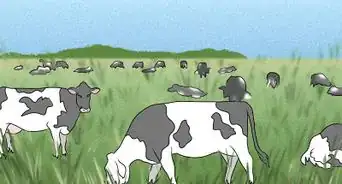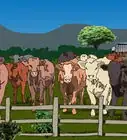wikiHow is a “wiki,” similar to Wikipedia, which means that many of our articles are co-written by multiple authors. To create this article, 23 people, some anonymous, worked to edit and improve it over time.
This article has been viewed 351,531 times.
Learn more...
There is more than one way to raise cattle, that is something that everyone, beginner and veteran cattlemen alike can agree with. How cattle are raised not only depends on the individual raising them, but the breed, class and type of cattle in concern. For instance, beef cows are raised differently from dairy cows: beef cows are raised to live with minimal management and raise a calf that, in 95% of all cases are sold for beef, and dairy cows are raised to give milk, but not raise a calf. As far as beef cattle are concerned, there are far more variations as how these type of cattle are raised than with dairy cattle.
As such, this article will only focus on the general aspects of raising cattle, only briefly touching base with both beef and dairy production practices. Thus please do not take this article as a specific how-to, but as a means to understand what is expected and involved in raising cattle.
Steps
-
1Purchase and start up your cattle herd. You will have needed to have chosen your cattle before you purchase them in order to start up the operation you're managing.
-
2From the business plan you created before starting your cattle operation, carry through with the various operational and strategic plans you had set out as best as possible. You may find out soon enough that some of your plans may not work out like you expected and you may have to make some compromises whenever and however necessary.[1]
- However, usually very few plans, if any would require any major changes or rethinking if you have done your research as thoroughly as possible before purchasing your animals.
- The main things that you need to follow through from your business plan include the following (a few are mentioned in the proceeding steps):
- Breeding (dairy and beef cow-calf only)
- Calving (dairy and beef cow-calf only)
- Weaning (beef cow-calf primarily, dairy as well if calves also raised on-farm)
- Marketing and selling livestock of various classes (all sectors: dairy, beef cow-calf, backgrounding/stocker and feedlot)
- Replacement heifers selection criteria and management (dairy and beef cow-calf only)
- Cull cow/bull/heifer criteria and management (dairy and beef cow-calf only)
- Herd bull management (primarily beef cow-calf, some dairy)
- Milk production (dairy only)
- Care of bottle calves (dairy only) or orphaned calves (beef cow-calf)
- Herd health management including vaccination/deworming schedules (all sectors)
- Feeds, feeding and pasture management (all sectors)
- Handling and disposal of deadstock (all sectors)
- Crop and/or hay production (all sectors)
- Human resource management (primarily dairy and feedlot, some beef cow-calf especially with cattle ranches)
- Capital and assets including fences, machinery, equipment and buildings in terms of maintenance, repairing and building new (all sectors)
- Goals and objectives for future improvements (all sectors)
- Succession and dispersal of herd and/or farm (all sectors)
Advertisement -
3Keep up with feeding and/or pasture management. You cannot raise cattle if you have nothing to feed them or no pasture for them to graze on. Make sure you have the feed available before you have purchased your animals or adequate pasture. Cattle eat grass, hay, silage and grain, and tend to be raised best on the first two or three.
- What type of feeds you wish to feed your animals depends on what type of cattle you're raising, your goals and your location. For instance, you can easily raise a beef cow-calf herd on just grass and hay or raise some backgrounder/stocker calves on grass for the summer. Fattening cattle the conventional way primarily requires silage and grain, and feeding dairy cattle requires that plus moist hay in the form of haylage.
- Some dairy cattle may also be allowed to graze for part of the year or most of the year as well, depending on whether the operation is an organic grass-fed dairy or not.
- For pasture, make sure you have an adequate stocking rate or stocking density so you avoid overgrazing. Ideally you should try to rotationally or manage-intensive graze your pastures as much as you can.
- What type of feeds you wish to feed your animals depends on what type of cattle you're raising, your goals and your location. For instance, you can easily raise a beef cow-calf herd on just grass and hay or raise some backgrounder/stocker calves on grass for the summer. Fattening cattle the conventional way primarily requires silage and grain, and feeding dairy cattle requires that plus moist hay in the form of haylage.
-
4Maintain a good herd health program. This especially so if it's needed. A herd health program is especially imperative if you are purchasing cattle and bringing them into your herd, because these new cattle could be carriers of disease that may affect your current herd. It's also important if you are raising them in an area where disease and illness tends to be prevalent, such as confined in a barn or out on a dirt lot, or feeding them feed, like grain, that tends to cause problems.[2]
- A herd health program is not just about what products are available to use to vaccinate, deworm/delice or treat animals, it's all about prevention as well, and what you can do to prevent illnesses and diseases from occurring. Prevention steps include and are not unlimited to vaccinations, quarantine periods, avoiding doing activities with cattle during certain times, ensuring adequate feed and minerals are available, and maintaining a good strict culling program.
- You must also know and have certain items on hand in case of an emergency. Items such as calving chains, calf puller, epinephrine, dexamethazone, trocar and canola, mineral oil, esophageal tube with frick tube, rope (lariat and/or cotton or poly rope), latex gloves, shoulder-length gloves, extra needles and syringes, Dettol (or a similar disinfectant), 70% alcohol solution, among many others should be in an emergency kit (items ultimately depend on what type of cattle you have) in case anything goes wrong and a veterinarian is not able to arrive on time.[3]
- You may eventually have to face the hard truth that some animals cannot be cured, and you may have to euthanize it yourself. Most producers use a gun to put an animal down, simply by putting a bullet in the middle of the forehead just above the eyes. It is the quickest and most humane way to put a suffering animal out of its misery instead of simply letting it die a slow and painful death on its own.
-
5Know how to deal with deadstock. With raising livestock it's entirely expected that you may end up having a dead animal (or more) on your hands to deal with. Research your local livestock disposal laws to determine what is best to dispose of a dead animal's carcass.[4]
-
6Know when, where and how to market or sell your animals. There are five main routes of selling cattle: salebarn/auction mart, private-treaty, direct sales, purebred sales and dispersal sales.
- The majority of cattle are sold through the sale barn or auction mart. Emphasis is placed on cull cattle, weaned calves, and fats (cattle ready for slaughter). Usually it is here where "problem cattle" get dropped off to go to the kill pen or be sold for slaughter, and weaned calves change hands from the ranch where they were born to a feedlot or farm that backgrounds them and readies them for slaughter. Usually replacement stock are not purchased here, unless the prices are very good and producers are willing to get rid of more than their fair share of cattle, no matter if they have problems or not. Cattle can be sold through live internet auction or simply hauling them in the trailer to the nearest auction mart to you. Both beef and dairy cattle are sold this way.
- Private treaty is where you negotiate sales or purchases of livestock between the buyer or seller, which ever you and the other person happen to be. You can sell cattle in an advertisement posted in the local newspaper, magazine or an Internet classified site such as Craigslist or Kijiji. People who read your ad may want to contact you for information or out of interest in the cattle you have up for sale. Private treaty sales may also come about from word-of-mouth, and not from reading newspaper or Internet advertisements at all.
- Direct sales would also work in the same way as private-treaty, except you are mostly selling beef, not live cattle, directly to a consumer interested in your product. Direct sales happen through word-of-mouth, an advertisement posted on your website marketing your product as "nothing but the best," or a little ad in a local newspaper. It also occurs when selling your product at a stand at a farmer's market.
- Purebred sales are only for those with purebred seedstock or cow-calf herds and are marketing live, purebred cattle for other producers, purebred or commercial themselves, to purchase. Yearling bulls and heifers are primarily sold this way, either through auction on-farm, or through advertisements to encourage private-treaty sales.
- Dispersal sales are sales where you can sell a whole herd or most of your herd of cattle to other interested buyers, be they meat packers or other producers. Dispersal sales are only for the purpose of selling almost your whole cow-calf herd, not if you were selling you're year's worth of stocker cattle you purchased several months ago.
-
7Manage other enterprises such as crops, hay and silage. If you are a producer that prefers to make their own feed rather than purchase it, this is one of the most important enterprises for your operation. You may be an operation that focuses on all three, just one, or any of the two. That all depends on what kind of cattle you run and whether you aim to be more conventional (graze in the summer, confine and feed in winter), or low-cost natural (graze all year round, grass-only, no grain or silage to feed). Whatever you choose, these enterprises must be managed in such a way that they give back to you in being good-quality feed for your livestock.
- Crops must be seeded and harvested on time.
- Silage must be harvested at the right stage, neither too late or too soon.
- Hay must be done properly to ensure no spoilage occurs, nor potential for combustion. Cut at the right time, allow it to dry, then rake and bale. Store bales as necessary, especially squares, since they're more prone to spoilage than round bales.
- Machinery for any and all enterprises must be kept in good working order. They do not have to be brand new, but they must be greased, oiled, maintained and broken parts repaired in order for them to keep working smoothly and efficiently.[5]
-
8Maintain good records of your operation. Anything goes here, with simple paper records to highly detailed computerized worksheets. Regardless of the type of records you keep, be consistent about keeping up to date with all records as you go along.[6]
- Records for raising cattle include, but are not limited to:
- Health records (which cattle were sick, illness ID, treatment, vaccinations, deworming, etc.)
- Breeding records (which cow/heifer was bred to which bull, when they were bred, which females turned up open after breeding season, etc.)
- Calving records (which female had which calf, calving troubles, when which cow calved, sex of calf born, etc.)
- Financial records (expenses, loans, rent, utility bills, income, etc.)
- Records for raising cattle include, but are not limited to:
-
9Always know where you stand financially by keeping up with bank statements, cash flow, balance sheets and income statements. This is a good way to tell if you are making money or losing money. Don't panic if you see you are losing money if you are in the process of starting up a cattle operation, but you should be worried if you're still losing money if you're operating ten years down the road. If you're breaking even or even gaining a little income, give yourself a pat on the back for a job well-done.
-
10Enjoy it. You won't make much money from it; so if you're in it for the money you're in the wrong business. Raising cattle has became and remained more of a way of life than a money-making enterprise, and thus is one that requires more of a want to raise cattle than a need due to the want for more money. You'll find it a challenge and a difficulty at times, sometimes asking yourself why you wanted to get involved in raising these critters in the first place, but you'll just keep loving it and keep wanting to do it.
Community Q&A
-
QuestionHow much money do I need to start the business?
 Community AnswerAt the very least $20,000, but likely more.
Community AnswerAt the very least $20,000, but likely more. -
QuestionHow can I get a calf?
 Community AnswerYou can buy a calf through auction, local classifieds or newspaper ads. You could also consult farmers in your area.
Community AnswerYou can buy a calf through auction, local classifieds or newspaper ads. You could also consult farmers in your area. -
QuestionWhy is my cow's milk fat low in the morning but high at night?
 KarinTop AnswererIf you are feeding hay once a day, and in the afternoon, this can cause milk fat levels to increase at night. Fat levels decrease when you feed grain instead. So to get a better, more even spread of milk fat day and night, increase the hay in the diet and start feeding this, plus some grain, twice a day instead of once. More long-stemmed fibrous feeds in the diet encourage more milk fat production.
KarinTop AnswererIf you are feeding hay once a day, and in the afternoon, this can cause milk fat levels to increase at night. Fat levels decrease when you feed grain instead. So to get a better, more even spread of milk fat day and night, increase the hay in the diet and start feeding this, plus some grain, twice a day instead of once. More long-stemmed fibrous feeds in the diet encourage more milk fat production.
Warnings
- Cattle are large animals and deserve to be treated as large animals, not small cats and dogs. Never spoil a bovine, otherwise that will make them think they're always the boss and never you.⧼thumbs_response⧽
References
- ↑ https://www.beefmagazine.com/communication/6-components-strong-ranch-business-plan
- ↑ https://beef.unl.edu/nebraska-bqa-building-herd-health-program
- ↑ https://www.lambertvetsupply.com/wellpetpost-first-ad-kit-for-cattle.html
- ↑ http://ontarioveal.on.ca/wp-content/uploads/2015/07/dealing-with-deadstock.pdf
- ↑ https://extension.psu.edu/managing-machinery-and-equipment
- ↑ http://vikaspedia.in/agriculture/livestock/cattle-buffalo/importance-of-record-keeping-at-livestock-farm
